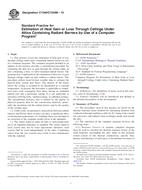Potrebujeme váš súhlas na využitie jednotlivých dát, aby sa vám okrem iného mohli ukazovať informácie týkajúce sa vašich záujmov. Súhlas udelíte kliknutím na tlačidlo „OK“.
ASTM C1340/C1340M-10
Standard Practice for Estimation of Heat Gain or Loss Through Ceilings Under Attics Containing Radiant Barriers by Use of a Computer Program
Automaticky preložený názov:
Štandardná prax pre odhad Tepelná zisk alebo stratu v stropy v podkroví obsahujúcich Radiant prekážok za použitia počítačového programu
NORMA vydaná dňa 1.6.2010
Informácie o norme:
Označenie normy: ASTM C1340/C1340M-10
Poznámka: NEPLATNÁ
Dátum vydania normy: 1.6.2010
Kód tovaru: NS-10764
Počet strán: 22
Približná hmotnosť: 66 g (0.15 libier)
Krajina: Americká technická norma
Kategória: Technické normy ASTM
Anotácia textu normy ASTM C1340/C1340M-10 :
Keywords:
attic radiant barrier system, computer program, heat gain, heat loss, Attic insulation, Automated procedures, Ceilings, Computer programs, Heat gain/loss, Heating tests--thermal insulation, Radiant barrier systems (RBS), ICS Number Code 91.120.10 (Thermal insulation of buildings)
Doplňujúce informácie
| Significance and Use | ||||||||
|
Manufacturers of radiant barriers express the performance of their products in terms of the total hemispherical emittance. The purpose of a radiant barrier is to decrease the radiation heat transfer across the attic air space, and hence, to decrease the heat loss or gain through the ceiling below the attic. The amount of decrease in heat flow will depend upon a number of factors, such as weather conditions, amount of mass or reflective insulation in the attic, solar absorptance of the roof, geometry of the attic and roof, and amount and type of attic ventilation. Because of the infinite combinations of these factors, it is not practical to publish data for each possible case. The calculation of heat loss or gain of a system containing radiant barriers is mathematically complex, and because of the iterative nature of the method, it is best handled by computers. Computers are now widely available to most producers and consumers of radiant barriers to permit the use of this practice. The user of this practice may wish to modify the data input to represent accurately the structure. The computer program also may be modified to meet individual needs. Also, additional calculations may be desired, for example, to sum the hourly heat flows in some fashion to obtain estimates of seasonal or annual energy usages. This might be done using the hourly data as inputs to a whole-house model, and by choosing house balance points to use as cutoff points in the summations. |
||||||||
| 1. Scope | ||||||||
|
1.1 This practice covers the estimation of heat gain or loss through ceilings under attics containing radiant barriers by use of a computer program. The computer program included as an adjunct to this practice provides a calculational procedure for estimating the heat loss or gain through the ceiling under an attic containing a truss or rafter mounted radiant barrier. The program also is applicable to the estimation of heat loss or gain through ceilings under an attic without a radiant barrier. This procedure utilizes hour-by-hour weather data to estimate the hour-by-hour ceiling heat flows. The interior of the house below the ceiling is assumed to be maintained at a constant temperature. At present, the procedure is applicable to sloped-roof attics with rectangular floor plans having an unshaded gabled roof and a horizontal ceiling. It is not applicable to structures with flat roofs, vaulted ceilings, or cathedral ceilings. The calculational accuracy also is limited by the quality of physical property data for the construction materials, principally the insulation and the radiant barrier, and by the quality of the weather data. 1.2 Under some circumstances, interactions between radiant barriers and HVAC ducts in attics can have a significant effect on the thermal performance of a building. Ducts are included in an extension of the computer model given in the appendix. 1.3 The values stated in either SI units or inch-pound units are to be regarded separately as standard. The values stated in each system may not be exact equivalents; therefore, each system shall be used independently of the other. Combining values from the two systems may result in non-conformance with the standard. |
||||||||
| 2. Referenced Documents | ||||||||
|
Odporúčame:
Aktualizácia technických noriem
Chcete mať istotu, že používate len platné technické normy?
Ponúkame Vám riešenie, ktoré Vám zaistí mesačný prehľad o aktuálnosti noriem, ktoré používate.
Chcete vedieť viac informácií ? Pozrite sa na túto stránku.




 Cookies
Cookies
